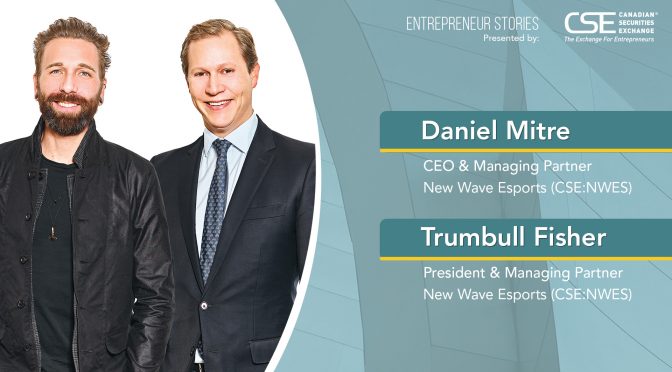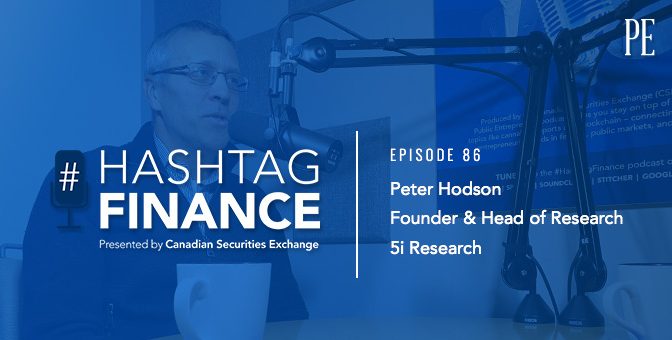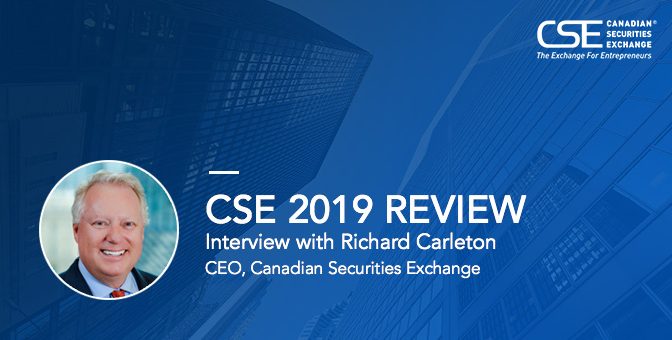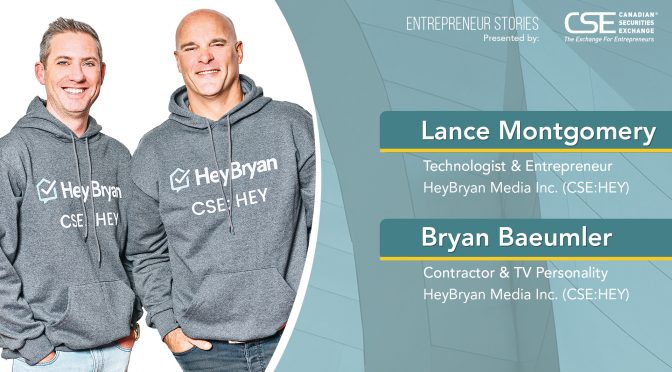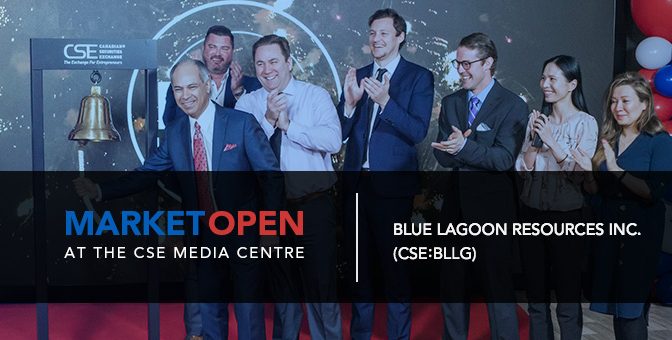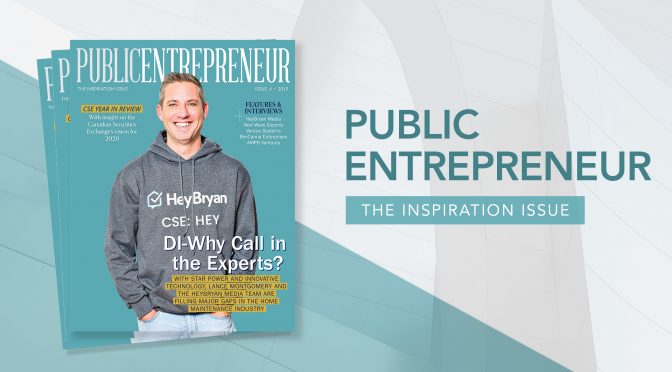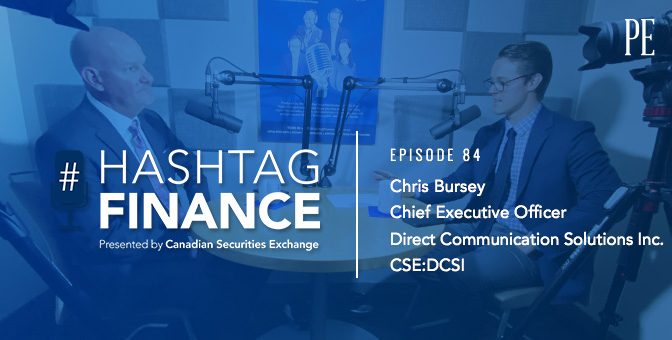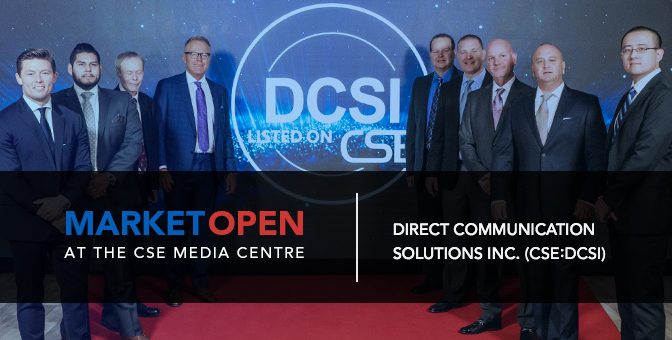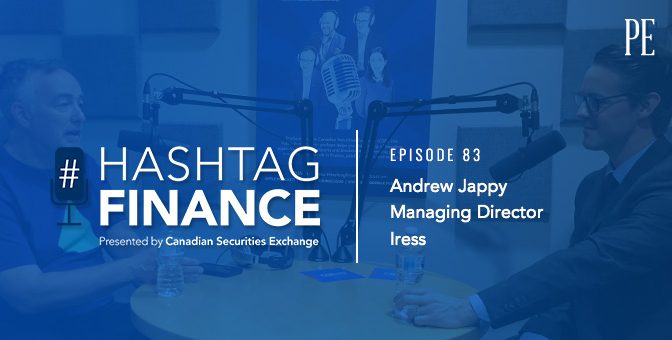The CSE is known to share milestone moments with their newly listed companies, but it also celebrated some major milestones of its own this past year. In addition to its 15th anniversary in 2019, the CSE also celebrated 129 new listings – including three Israeli companies – the signing of an MOU with the Jamaica Stock Exchange, and a growing team of over 50 employees. Scroll on for an exclusive, in-depth interview with CSE CEO Richard Carleton, as he discusses industry challenges from 2019, areas of growth for the CSE, and what’s in store for the new decade.
PM: First of all, congratulations on marking your 15th year as an exchange in 2019. We’ll review some developments in a moment illustrating how the CSE has grown in size and stature. But let’s begin by discussing what it’s like to take a concept built around superior issuer service and grow it into a securities exchange that now routinely attracts listings and capital from around the world.
RC: The quick answer is that we are not ready to declare victory just yet. Yes, we are pleased, and in some respects, humbled, with the success we have had to date. But we know there is a lot more work to do to provide the best possible listing and trading environment for issuers and investors before we can really feel any significant level of satisfaction.
We still have a lot of work to do on improving access to the CSE from outside of Canada. We also want to engage with the institutional investor community to provide a greater diversity of shareholders for CSE issuers so we are able to expand beyond the traditional base of retail investors who have supported CSE issuers to date. There is still quite a bit of work for us to do to provide that best possible experience for issuers and the investing community.
Back to top
PM: Comment for us on market quality. The CSE team has been very successful at establishing relationships on the data side and ensuring easy access for investors to place orders. Are we seeing the hallmarks of a quality market, such as market depth, tight spreads and lower volatility? And what is the CSE doing to continue to enhance market quality?
RC: We are constantly looking for ways to improve all of the benchmarks of market quality you mentioned, whether it’s spreads, turnover, trade continuity, or other measures. And let’s face it, it is particularly challenging in the small cap space, where companies can be subject to significant levels of volatility.
Again, we think that providing as broad access as possible to all categories of investors in Canada, the United States and beyond is key in terms of improving market quality. The more participants you have in the auction process, the better the outcomes will be for investors, as well as for companies looking for an appropriate valuation of their shares and the ability to conduct financing activities at the lowest possible cost of capital.
Back to top
PM: European retail and institutional investors often participate in North American small cap opportunities. What can you tell us about trading access for European investors?
RC: Canadian and US small cap markets got caught up in a European securities regulator initiative a few years back to limit access to the so-called penny stock market. As a result, most of the bank- and institutional-owned advisors in Europe are unable to provide trading services for companies listed on the CSE, over the counter in the United States, and various other markets that cater to small cap companies.
That said, we have made inroads in improving coverage from the “self-directed” market in Europe, and that has assisted companies in broadening their shareholder base to interested retail and private investors on the continent. These folks have become an important source of capital for our issuers: in the cannabis space, for instance, 15% of the capital raised in 2019 came from Europe. So, people who have conviction are finding a way to trade shares from overseas.
All that having been said, the CSE team continues to work with various platforms and service providers who can manage that order flow into Canada from other parts of the world, and that will be an important area of focus for us in the coming year.
Back to top
PM: Let’s look at a few numbers: listed securities up 23% in 2019 to 569, total value of financings down 42% to $3.15 billion, trading volume down 31% to 19.8 billion shares, and value of trading down 17% to $16.9 billion. Despite these declines in KPIs, 2019 still stands as the second best year for trading and financing in the exchange’s 15 year history. Take us behind those numbers and tell us what you saw and heard to help us make sense of it.
RC: It’s really quite straightforward. On the finance side, 2018 was the year that the big US multistate operators came into the Canadian Securities Exchange. We saw record amounts of money raised that year, led by a handful of very large US companies. As valuations fell in 2019, companies were not in the same strong position to raise additional capital by way of a secondary offering. It would have represented considerable dilution of the original investors.
We saw a real shift in 2019. There was a lot less capital raised in the cannabis sector and, secondly, the capital that was raised was through secondary offerings of convertible or debt-related securities issued by existing companies. And I think it’s fair to say that there were a lot of private companies in the United States that took a wait-and-see attitude in 2019 to watch whether valuations for US companies would recover. And if and when they did, those companies would be re-visiting their plans to do a public offering.
I’m pleased to say that, from the beginning of November, the US cannabis group is up more than 20%, with the positive price performance accelerating in recent weeks. That should be a positive leading indicator for us for the coming year.
Back to top
PM: The CSE’s growth has been driven by multiple industry sectors, but far and away the most important for the past few years has been cannabis. It’s fair to say that this sector ended 2019 with some challenges on its hands. Talk to us about 2019 in terms of the way the market transitioned for cannabis, and what are you hearing that might be of use to those trying to understand where it goes next?
RC: The cannabis sector as a whole traded with very high correlations through 2019. What I mean is that whether the company was a Canadian cultivator, an extraction company, a US multistate operator, or another type of company, the stocks tended to trade up and down with a very high degree of correlation.
That was a source of some frustration for the management teams of US companies, as many of them were meeting or exceeding their revenue and earnings forecasts. Many are doing really well and expanding their networks into additional states. So, those companies, while they may have a different set of challenges in front of them than do Canadian LPs, have an addressable market that is already significant and will only grow going forward. We are beginning to see support for that theme, and it does look like the correlations are breaking down; companies are being judged more on specific achievements than prevailing sector sentiment.
Back to top
PM: What about other sectors? Are there any already shaping up with a particularly interesting outlook as we begin 2020?
RC: We did a lot of outreach to the esports community last year and we have had success with some listings in that space already. It is a very interesting market. I don’t think it is clear what the most successful investment approach in the sector will be, but I believe investors accept the idea that as time goes on, people will spend more money and time on esports.
But in terms of the number of companies that joined the exchange last year, half of them were gold exploration companies. That was certainly driven by the fact that the value of the underlying commodity increased last year to well above $1,500 per ounce. And after many years of very little activity in the space, we saw a number of get funding, join the public markets and begin to pursue exploration programs. We see that continuing in 2020, in all likelihood, particularly given the backlog of applications to list on the CSE and continued strength in the price of gold. I guess it is kind of getting back to our roots in many respects, as for most of our existence the mining sector has been far and away the largest industry group on the exchange.
Back to top
PM: With mineral exploration taking on renewed importance, do you have any thoughts on the Save Canadian Mining initiative and the impact of short selling on the mining industry?
RC: The issue is not short selling as much as it is abusive short selling. And we already have a lot of rules in place designed to curb abusive short selling. I am concerned that some of the measures proposed, regarded by many as a panacea, may not in fact be the magic bullets they are purported to be.
I think that the first step is taking a hard look at whether our current rules are being circumvented in any way. We certainly don’t lack anecdotal testimony about the evils of abusive short selling. But it is a complicated issue and I have concerns that you could materially affect share turnover and liquidity if we make well-intentioned but poorly applied changes to the short sale rules. As I say, it is a very complicated topic, and to the extent that there is abusive short selling taking place, I believe that it is likely well within IIROC’s ability to address right now without any additional rules.
Back to top
PM: The plan to create a senior tier at the CSE was revealed in 2019. What is the status, and is there any interesting feedback you can share with us from issuers, regulators or others regarding this idea?
RC: Basically, we have completely rewritten the listings manual for the Canadian Securities Exchange in order to effectively create two tiers of issuers. This is designed to reflect the distinctions in Canadian securities law related to venture issuers and non-venture issuers.
Non-venture issuers, who are the more senior companies with larger market capitalizations and complexity of operations, have different rules around corporate governance, financial reporting and continuous disclosure. Timelines for them to report quarterly and annual audited financial statements and other burdens more appropriately borne by larger companies are a good example.
We have a significant cohort of companies which, if they were listed on two of the other exchanges in Canada, would be categorized as non-venture issuers. We think it is appropriate to put in place a formal framework to ensure that those companies are regulated by us as non-venture issuers, as they are on other marketplaces.
It is important that comparable companies are subject to the same level of oversight and regulation. The companies win because investors know that there is no possibility of regulatory arbitrage or differences in reporting between the CSE and other exchanges. If companies on the senior tier become eligible for margin under IIROC rules, as we are working towards, that will improve liquidity in those names because trading and corporate finance costs should go down.
We have completed the work and are now basically huddled with regulators in BC and Ontario on the final few points. We hope to get clearance from the regulators to soon publish the new listings manual for a 30-day public comment period. If all goes well, we look to implement these new rules shortly after the 30-day comment period expires, and on the receipt of formal regulatory approval from the two commissions.
Back to top
PM: What, if any, impact will this have on fees at the exchange? Your fee structure has always been a factor that differentiates you positively from other exchanges.
RC: We have made some adjustments to our fee schedule for issuers. This is both for applications and for what we refer to internally as hosting fees, i.e. the monthly fees that companies pay over the life of their listing on the exchange. We have established four tiers, which are market capitalization-related, with different levels of fees.
Going into this exercise we knew there were a few governing principles. We knew that we wanted to maintain one of our key strengths from a pricing perspective, and that is cost certainty. So, regardless of how much activity a company engages in – whether it is secondary financings, business changes or another activity – they are going to pay the same to us regardless.
Secondly, we know that as the relatively new kid on the block, we do need to be cost-competitive with all of the alternatives, whether they be exchanges in Canada, or the over-the-counter market in the United States, or some of the venues in Europe that cater to early stage companies. We have achieved that in this exercise, but we still gain considerable resources, both from the growing number of listed companies and the fee increases that have been introduced. It enables us to reinvest in the work that we do on behalf of our issuers in a variety of ways, one of them being to help them tell their story in a number of ways to a market that is very crowded and competitive.
Back to top
PM: The second half of last year saw three companies from Israel list on the CSE, the first ones from that country. You signed an MOU with the Jamaica Stock Exchange. How important are international activities to the CSE today, and how do you see them being important in the years ahead?
RC: Our international activities have largely been driven by our support for and involvement in the cannabis industry. The three Israeli companies that have listed are in different parts of the cannabis space, and we have the same situation with the Jamaica Stock Exchange. There is a significant legacy industry in Jamaica which is in the process of being legalized. It is a low-cost cultivation jurisdiction, but they have challenges locally from banking and other perspectives in listing and trading those stocks. Our work with the Jamaica Stock Exchange is to help Jamaican companies raise capital from Jamaican and CSE investors and have a liquid market in their securities here on the CSE, which is something we are really looking forward to.
In the case of the Israeli issuers, we have done good work with the OTC Markets Group out of New York, collaborating on what essentially amounts to access to North America in a single transaction. Companies that become Canadian reporting issuers and list on the Canadian Securities Exchange, in addition to being able to raise money from Canadian investors, are also able to take advantage of prospectus exemptions in the United States to do private placement financings with US investors. These companies are also able to access liquidity in the US through the markets operated by the OTC folks.
This is a very powerful tool. For a small Israeli company to consider the ability to work in the United States, it is a very big leap, and very expensive, and risky. We can cut a lot of this cost and risk out by providing them access to North America through a CSE listing.
Back to top
PM: The CSE does a lot of work on behalf of the issuer and dealer communities that people never hear about. Is there anything interesting going on in regulatory or other realms that the exchange is helping to shape?
RC: We are an active and engaged participant in the ongoing debate over public capital markets policy. We routinely submit comment papers to the securities commissions and are represented on a number of stakeholder committees and industry boards to advance the interests of our listed companies.
The biggest challenge for companies who are nearly public, in reality, is coming to grips with the fact that the going-public transaction is not the goal, but rather just the beginning of the heavy lifting. Companies really do need to understand that they have to tell their story and win mindshare from investors in order to stand out from what is a very, very large group of peers.
What we’ve tried to do is give them opportunities to tell their unique stories in a number of different ways. We initiated market opening ceremonies for our issuers, which tie in with various media outlets with whom we are affiliated to give them more exposure. We also created a podcast studio inside our head office where issuers and thought leaders from different industries have conversations about issues of interest to the CSE community. There has been great pickup on these services, as we can see how many people listen to a podcast and how many people follow us on social media. So, there is that sort of general work that we do to provide our issuers with opportunities to tell their stories.
We are going to do more work in the coming year to teach companies about the public markets. How can they boost liquidity in their shares? What are the things that work for companies? And there are questions around market-making, and marketing activities – what are the marketing activities you need to undertake, what are the trade shows you need to be at? We try to really act as a concierge to give them access to as many opportunities as we can to help them navigate what is a very complicated, confusing and difficult world.
Back to top
PM: The CSE now has over 50 employees. How do you see the continuous expansion of the CSE influencing your culture, and what is the impact on your clients, the companies who list on the CSE?
RC: Well, so far, the growth has not come at the expense of what I believe is an enthusiastic, fun-loving, “don’t take yourself too seriously, but do take your work seriously” kind of culture. And if that comes from the top, that’s great, as it’s entirely intentional. Our employee turnover is low, and the experience level is very high. I think we do have a healthy and strong culture in the company, and I am looking forward to seeing that continue in the future.
I get tremendously encouraging feedback from our clients – the issuers, the dealer firms and others – about how positive their interactions with our team members are, and that is extremely gratifying. In fact, that is about as good as it gets. I understand that those types of compliments are not won easily. From my perspective, it is very gratifying when I get that kind of feedback.
Back to top
PM: Finally, can you share with us your expectations for the exchange in 2020? And what do the next 15 years hold for the CSE?
RC: That’s easy – there will be another chief executive at the helm 15 years from now, I’m pretty sure. Nearer term, we clearly have a few key projects. We’ve talked about the new rulebook that will see the introduction of a senior tier, with the knock-on effect of margin eligibility for issuers. We haven’t mentioned that the new rulebook provides for the ability for the CSE to list ETFs and Special Purpose Acquisition Corporations, which is a vehicle that has proven popular for issuers to raise capital. So that will have a positive effect for us and provide new and interesting vehicles for investors.
We also haven’t talked about our clearing and settlement initiative to list, trade, clear and settle tokenized securities. We have been quietly working away on that last year and into 2020. I expect this is the year we will be making a formal application to the regulators for that clearing facility. It is a significant undertaking and there are a lot of different people at the exchange engaged in the effort. And again, we continue to receive a lot of support and interest from the issuer community to implement this ability to use securities tokens to raise capital.
As far as the longer term, I think there are some interesting challenges ahead for public markets generally. There is a lot of competition from different forms of private equity investment. Whether that is private equity or venture capital or different sources of non-public financing. Public markets are really going to have to continue to make their case to consumers of investment capital and constantly address areas of inefficiency and cost. You don’t have to look very hard to see studies or commentary on the benefits of staying private, for the technology and life sciences industries in particular. I think that is going to be a big theme over the next few years. Essentially, is the existence of the public market assured? Is the Canadian Securities Exchange going to continue to be a venue for companies to raise capital? Or, is it instead going to be an exit for the early stage investors who are looking for public market liquidity? I think that is a hugely important debate that is already taking place, and the continued existence of the status quo is simply not assured.

